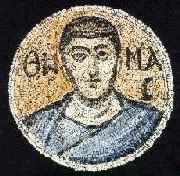15
 Readings:
The
Gospel of Thomas
Readings:
The
Gospel of Thomas
and Q (the lost source used by Matthew and Luke)
Topic: Jesus as Rabbi and the Role of Oral Tradition (case study: the Parable of the
Tenants)
The link to the text of the Gospel of Thomas is given immediately below:
(http://www.misericordia.edu/users/davies/thomas/Trans.htm)
Background. The Gospel of Thomas is a collection of 114 sayings (logia) of Jesus that were collected over time. The earlier sayings in this collection were derived from oral tradition and written down before the Gospel of Mark was written. They are in the nature of "wisdom sayings" -- similar in nature and in some cases overlapping with the proverbs and parables of Jesus recorded in the New Testament gospels. Over time this gospel grew by the addition of other sayings from ongoing oral traditions that were influenced by Christian visionary experience and Gnosticism. In its final form, the overarching perspective is a form of Gnosticism, so in its final form, as we have it today, this text is generally considered to be a Gnostic gospel. Unlike the New Testament gospels, this gospel has no story line and no account of Jesus' death and resurrection. It resembles, in that way, the document known as Q that both Matthew and Luke incorporated into their gospels. Q was also a collection of sayings, and also had no story line and no account of Jesus' death and resurrection. Mark may also have used an early written collection of sayings for the string of parables found in Mark chapter 4.
Preparations: Do as much as you can with the following 4 preparations -- if you can't do them all, pick out a few questions from these preparations that are especially interesting to you and focus on those. We will attempt to draw some conclusions about all of these questions in our session.
1. Preliminary: Find some passages in Mark where Mark presents the apostles in bad light, then ask yourself, "Why would Mark have treated the apostles so negatively?" Some hints: On the one hand, Mark is written in Greek; What kind of an audience does he seem to have in mind? On the other hand, what language would the disciples of Jesus have spoken? How did they view Jesus, judging from the titles they used in addressing him?
2. Mark: Read the passion narrative (the story of Jesus' death) and the following resurrection story. How does Mark interpret this story? That is, what, for Mark, is the significance of this story? (Compare Mark 8:31-33, 9:30-32, & 10:33-34 -- Jesus' three prophesies about his death -- and notice Mark's description of the responses of the disciples.) Compare Paul's interpretation: for example, Romans 3:21-26; 5:6-21.
3. The Early Thomas: Read and compare the Markan and Thomasine versions of the "Parable of the Tenants" (Mk 12:1 ff. and G Thomas 65, 66. The same parable also occurs in Matthew 21:33 ff and Luke 20:9 ff.). In Mark's version is an allegory, whereas in Thomas it is a parable. How does the plot of the story as Mark tells it differ from the that in the Gospel of Thomas? How does the allegory in Mark's version of the parable change the meaning from the parable as you read it in Thomas?
4. The Gnostic Thomas: (1) Read this gospel's account of Jesus' response to Peter's comment about Mary Magdalene (#114), who came to be a heroine among some of the Gnostic Christian groups. (2) Read the opening three sayings (#1-3). How does Jesus understand the Kingdom of God in this opening? How does this compare with Mark? (3) Read the following "Gnostic" sayings; by comparing them, try to identify some central concepts or themes of the Gnostic (Thomasine) view of Jesus' teaching, and bring your ideas or questions about them to this session: Sayings 11, 13, 15, 18, 19, 22, 28, 30, 48, 49-50, 59, 60, 61, 83-84, 100, 101, 105. Finally, (4) What conclusions can we draw about this gospel's views on resurrection and the concept of atonement of sin through Jesus' sacrificial death on the cross as opposed to what we find in Mark and Paul?
Interesting Web Site:
Steven Davies' Gospel of Thomas Home Page (a href="http://users.misericordia.edu//davies/thomas/Thomas.html)
Gospel of Thomas FAQs (http://users.misericordia.edu//davies/thomas/faq.htm)